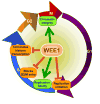WEE1 tyrosine kinase, a novel epigenetic modifier
- PMID: 23537585
- PMCID: PMC3700603
- DOI: 10.1016/j.tig.2013.02.003
WEE1 tyrosine kinase, a novel epigenetic modifier
Abstract
The cell cycle requires cells to duplicate their chromatin, DNA, and histones, while retaining a subset of epigenetic marks, in a highly coordinated manner. The WEE1 kinase was identified as an important regulator during S phase, preventing entry into mitosis until DNA replication has been completed. Interestingly, WEE1 has also emerged as a key player in regulating histone synthesis. It phosphorylates histone H2B at tyrosine 37 in the nucleosomes found upstream of the histone gene cluster, and this suppresses histone transcription in late S phase. These observations highlight a dual role for WEE1 as both a mitotic gatekeeper and a surveyor of chromatin synthesis, providing a direct link between epigenetics and cell-cycle progression. Importantly, this link has implications for the design of novel epigenetic inhibitors targeting cancers that display elevated expression of this kinase.
Copyright © 2013 Elsevier Ltd. All rights reserved.
Figures


Similar articles
-
H2B Tyr37 phosphorylation suppresses expression of replication-dependent core histone genes.Nat Struct Mol Biol. 2012 Sep;19(9):930-7. doi: 10.1038/nsmb.2356. Epub 2012 Aug 12. Nat Struct Mol Biol. 2012. PMID: 22885324 Free PMC article.
-
[WEE1, histone and tumor].Zhong Nan Da Xue Xue Bao Yi Xue Ban. 2015 Jul;40(7):806-10. doi: 10.11817/j.issn.1672-7347.2015.07.017. Zhong Nan Da Xue Xue Bao Yi Xue Ban. 2015. PMID: 26267696 Chinese.
-
Wee1 controls genomic stability during replication by regulating the Mus81-Eme1 endonuclease.J Cell Biol. 2011 Aug 22;194(4):567-79. doi: 10.1083/jcb.201101047. J Cell Biol. 2011. PMID: 21859861 Free PMC article.
-
WEE1 kinase limits CDK activities to safeguard DNA replication and mitotic entry.Mutat Res. 2020 Jan-Apr;819-820:111694. doi: 10.1016/j.mrfmmm.2020.111694. Epub 2020 Feb 25. Mutat Res. 2020. PMID: 32120135 Review.
-
Histone modifications and cancer.Adv Genet. 2010;70:57-85. doi: 10.1016/B978-0-12-380866-0.60003-4. Adv Genet. 2010. PMID: 20920745 Review.
Cited by
-
Cross talk of tyrosine kinases with the DNA damage signaling pathways.Nucleic Acids Res. 2015 Dec 15;43(22):10588-601. doi: 10.1093/nar/gkv1166. Epub 2015 Nov 5. Nucleic Acids Res. 2015. PMID: 26546517 Free PMC article. Review.
-
Sequential drug treatment targeting cell cycle and cell fate regulatory programs blocks non-genetic cancer evolution in acute lymphoblastic leukemia.Genome Biol. 2024 May 31;25(1):143. doi: 10.1186/s13059-024-03260-4. Genome Biol. 2024. PMID: 38822412 Free PMC article.
-
Simultaneously targeting DNA damage repair pathway and mTORC1/2 results in small cell lung cancer growth arrest via ER stress-induced apoptosis.Int J Biol Sci. 2018 Jul 13;14(10):1221-1231. doi: 10.7150/ijbs.25488. eCollection 2018. Int J Biol Sci. 2018. PMID: 30123071 Free PMC article.
-
Synthetic and Medicinal Chemistry Approaches Toward WEE1 Kinase Inhibitors and Its Degraders.ACS Omega. 2023 Jun 2;8(23):20196-20233. doi: 10.1021/acsomega.3c01558. eCollection 2023 Jun 13. ACS Omega. 2023. PMID: 37323408 Free PMC article. Review.
-
Development of new medical treatment for epithelial ovarian cancer recurrence.Gland Surg. 2020 Aug;9(4):1149-1163. doi: 10.21037/gs-20-413. Gland Surg. 2020. PMID: 32953630 Free PMC article. Review.
References
-
- Meeks-Wagner D, Hartwell LH. Normal stoichiometry of histone dimer sets is necessary for high fidelity of mitotic chromosome transmission. Cell. 1986;44:43–52. - PubMed
-
- Osley MA. The regulation of histone synthesis in the cell cycle. Annual review of biochemistry. 1991;60:827–861. - PubMed
-
- Schwartzentruber J, et al. Driver mutations in histone H3.3 and chromatin remodelling genes in paediatric glioblastoma. Nature. 2012;482:226–231. - PubMed
Publication types
MeSH terms
Substances
Grants and funding
LinkOut - more resources
Full Text Sources
Other Literature Sources

